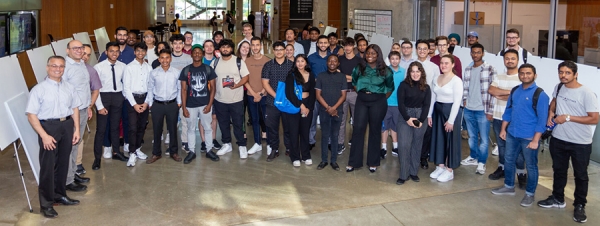 First-year engineering students in the cornerstone design course displayed their projects and competed for cash prizes.
First-year engineering students in the cornerstone design course displayed their projects and competed for cash prizes.
The Centre for Engineering Innovation atrium filled Aug. 4 with engineering students and faculty as first-year students of “cornerstone design” displayed their efforts and competed for cash prizes.
The mandatory course tasks students with designing, programming, and building a product to address a real-world issue. Solutions ranged from a sustainable greenhouse to an electromagnetic brake system, a sensor-augmented white cane, or an autonomous vehicle.
Harshan Bharat, Bruce Ye, and Vikashan Vivekanathan took the task to heart and created something off the beaten path. They found that white canes used by the visually impaired haven’t changed as much as other medical-related technology.
“Users of a white cane are more limited than you think,” said Ye. “They only have one meter of reach, and think what happens after that one meter” overhead obstacles, far away obstacles, or obstacles that approach you. They are all difficult to detect.”
He and his teammates came up with ultrasonic sensors to extend the range of the cane. The frequency would change depending on how close the user is from the object.
Professor Hassan Nameghi was pleased with all the resulting projects.
“I am proud of the accomplishments of students and their creativity in addressing important issues,” he said. “We as course facilitators put questions in the minds of future engineers, and they make great innovations.”
The students vied for a total of $3,000 in prize money.
Claiming first-place honours and $1,500 was the Sustainable Greenhouse Design team of Sarah Beneteau, Phylicia Krainz, and Naomi Nsoko. Bharat, Ye, and Vivekanathan finished second and received $1,000 for their Sensor-Augmented White Cane. The third-place team, Gravity Battery by Gravity Mastea team, Almughdad Fadlemola, Jason Holdaway, Aldin Malkic and Jenil Maniya, won $500.
—Naomi Pelkey
